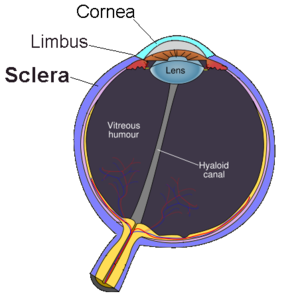This article may be too technical for most readers to understand. (February 2020) |
This article about biology may be excessively human-centric. |
| Sclera | |
|---|---|
 The sclera, as separated from the cornea by the corneal limbus. | |
| Details | |
| Part of | Eye |
| System | Visual system |
| Artery | Anterior ciliary arteries, long posterior ciliary arteries, short posterior ciliary arteries |
| Identifiers | |
| Latin | sclera |
| MeSH | D012590 |
| TA98 | A15.2.02.002 |
| TA2 | 6750 |
| FMA | 58269 |
| Anatomical terminology | |
The sclera,[note 1] also known as the white of the eye or, in older literature, as the tunica albuginea oculi, is the opaque, fibrous, protective outer layer of the eye containing mainly collagen and some crucial elastic fiber.[2]
In the development of the embryo, the sclera is derived from the neural crest.[3] In children, it is thinner and shows some of the underlying pigment, appearing slightly blue. In the elderly, fatty deposits on the sclera can make it appear slightly yellow. People with dark skin can have naturally darkened sclerae, the result of melanin pigmentation.[4]
In humans, and some other vertebrates, the whole sclera is white or pale, contrasting with the coloured iris. The cooperative eye hypothesis suggests that the pale sclera evolved as a method of nonverbal communication that makes it easier for one individual to identify where another individual is looking. Other mammals with white or pale sclera include chimpanzees, many orangutans, some gorillas, and bonobos.[5]
- ^ Mosby's Medical, Nursing, and Allied Health Dictionary (4th ed.). St. Louis: Mosby. 1994. p. 1402. ISBN 978-0815161134.
- ^ Cassin, Barbara; Solomon, Sheila A.B. (1990). Dictionary of Eye Terminology (2nd ed.). Gainesville, Fla.: Triad Pub. Co. ISBN 978-0937404331.
- ^ Hermann D. Schubert. Anatomy of the Orbit "New York Eye and Ear Infirmary of Mount Sinai - New York City - NYEE" (PDF). Archived from the original (PDF) on 2008-10-08. Retrieved 2008-05-19.
- ^ Mukamal, Reena (30 July 2020). "Why Are the Whites of My Eyes Discolored?". American Academy of Ophthalmology. Retrieved 11 December 2020.
- ^ Clark, Isabelle R.; Lee, Kevin C.; Poux, Tucker; Langergraber, Kevin E.; Mitani, John C.; Watts, David; Reed, James; Sandel, Aaron A. (2023-03-01). "White sclera is present in chimpanzees and other mammals". Journal of Human Evolution. 176: 103322. Bibcode:2023JHumE.17603322C. doi:10.1016/j.jhevol.2022.103322. ISSN 0047-2484. PMC 9998187. PMID 36706647. S2CID 256314941.
Cite error: There are <ref group=note> tags on this page, but the references will not show without a {{reflist|group=note}} template (see the help page).